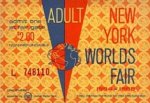 In last week’s NYC D23 event recap “Behind the Scenes Experience: Magic in Manhattan & More”, I did a quick flyover of Disney’s contributions to the 1964 NY World’s Fair. There’s way more to that story. Just as Walt used the Silly Symphonies shorts to test and perfect animation skills needed for his animated masterpiece, Snow White, he used the NY Fair to improve Disneyland.
In last week’s NYC D23 event recap “Behind the Scenes Experience: Magic in Manhattan & More”, I did a quick flyover of Disney’s contributions to the 1964 NY World’s Fair. There’s way more to that story. Just as Walt used the Silly Symphonies shorts to test and perfect animation skills needed for his animated masterpiece, Snow White, he used the NY Fair to improve Disneyland.
Walt grew up at the tail end of the World’s Fair era and probably attended at least one. The Fairs were opportun ities for countries, companies and organizations to offer a taste of current accomplishments and future promise. Although today you could argue we can get much more from the internet and we don’t have to wait years for it to come to our part of the world. But, we also don’t get the advantage of being able to “touch” things. But there was a time that cities like NY and Paris would spend tons of money to bring the world to their Fairs. By 1964, fair mania had begun to wane. So, it’s no surprise that when Fair organizer Robert Moses was looking for a sure-fire way to drive attendance, he approached Walt to contribute the Disney touch. Walt jumped in with great enthusiasm. But not just because he liked World’s Fairs.
ities for countries, companies and organizations to offer a taste of current accomplishments and future promise. Although today you could argue we can get much more from the internet and we don’t have to wait years for it to come to our part of the world. But, we also don’t get the advantage of being able to “touch” things. But there was a time that cities like NY and Paris would spend tons of money to bring the world to their Fairs. By 1964, fair mania had begun to wane. So, it’s no surprise that when Fair organizer Robert Moses was looking for a sure-fire way to drive attendance, he approached Walt to contribute the Disney touch. Walt jumped in with great enthusiasm. But not just because he liked World’s Fairs.
As usual, I won’t assume all my readers are familiar with the subject matter. So, first a little background on the ’64-65 NY World’s Fair. The brainchild of Moses, the self-styled urban planner, road builder, and master of disaster (couldn’t help let my negative view sneak in), the Fair was intended to last three years, make money for investors, and create a public park as a City legacy. It was billed as an international festival dedicated to “Peace Through Understanding” and a showcase of American industry. Walt even promoted it in a dedicated episode of The Wonderful World of Color called “Disneyland goes to the World’s Fair”.
In typical Disney TV fashion, the episode not only educated us on World’s Fair history, but plugged the Disney attractions. The work on the Fair put an enormous strain on WED, which had been working furiously for four years since Disneyland’s opening, adding new, innovative attractions like the Matterhorn Bobsleds (first steel rollercoaster) and building the world’s 8th largest navy for the Submarine Voyage. Why, then, with the success of Disneyland, would Walt turn his attention away from his latest labor of love?

Walt & Roy Disney
To maintain control over the Disneyland project, Walt had created a separate company, WED Enterprises (Walter Elias Disney), to do the development. Walt saw an opportunity to get deep pocketed corporations, inexperienced in theme parks, to fund new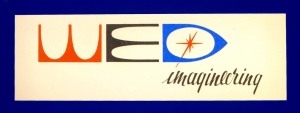 technologies and attractions. WED was already staffed with many future Disney legends like John Hench, Rolly Crump, Marc & Alice Davis, Mary Blair, and Bob Gurr who would drive theme park innovation, design and engineering for decades. Walt simply asked them to work on a few more projects. It seems he always made it sound so easy, no one questioned the effort it would take. They just went to work creating miracles.
technologies and attractions. WED was already staffed with many future Disney legends like John Hench, Rolly Crump, Marc & Alice Davis, Mary Blair, and Bob Gurr who would drive theme park innovation, design and engineering for decades. Walt simply asked them to work on a few more projects. It seems he always made it sound so easy, no one questioned the effort it would take. They just went to work creating miracles.
Ultimately, the Fair drew less people overall than had been expected, lost money and a planned third season was cancelled. But, the popularity of Disney’s four pavilions, Pepsi’s It’s a Small World, GE’s Progressland, (including the Carousel of Progress), Illinoi’s Great Moments with Mr. Lincoln and Ford’s Magic Skyway convinced Walt that an Eastern theme park would work. (He probably knew already, but needed to convince others)
As a Disney fan, today, I remember visiting Small World, COP and the Skyway at the Fair as a child (No memory of Lincoln). Little did I know then that the Fair would launch many celebrated innovations that would change theme parks and more forever. Before we get to the pavilion work, I want to mention one of the less celebrated Disney innovations introduced at the Fair, perhaps, more impactful to the world than any of the headliner attractions.
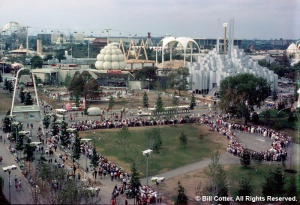
Walt, never let a good problem go to waste. Long waits at Disneyland attractions were commonplace from day one. The Fair, no exception, had similar lines. Walt had his people study the lines at the fair to devise new methods for queue management. In my recent tour of the Fairgrounds in Flushing, NY (see my previous post) I learned that the lines for the COP were crazy long, especially in the hot humid months of July and August. The solution was razing an unfinished building behind the Progressland pavilion and turning it into a covered overflow queue area. This area had the first use of the now familiar switch-back queuing system. Before you dismiss the significance of this creative solution, think about how often you encounter this kind of line system. It’s everywhere there’s a line that needs to be managed.
The four Disney attractions had some common elements that put them, consistently, at the top of everyone’s list of Fair favorites. First, if you keep my queue story in mind, except for Lincoln, which was a stage show, they were designed to maximize rider capacity. Attractions, today, like Small World and Pirates move people through by the hundreds an hour. Early Disneyland’s low capacity rides like The Rainbow Mountain Stagecoach Ride and The Phantom Boats didn’t last long. At the Fair, WED Imagineers tackled capacity issues with the debut of three different ride systems. Small World and Skyway were originally planned as walk-throughs. But, herding large numbers of people efficiently through was not Walt’s of showing off. The Small World boat system, designed by transportation genius, Bob Gurr, proved so efficient that it has been used in other attractions like Pirates of the Caribbean and other theme parks.
tackled capacity issues with the debut of three different ride systems. Small World and Skyway were originally planned as walk-throughs. But, herding large numbers of people efficiently through was not Walt’s of showing off. The Small World boat system, designed by transportation genius, Bob Gurr, proved so efficient that it has been used in other attractions like Pirates of the Caribbean and other theme parks.
Small World still moves ‘em through in all of its worldwide incarnations. But, the ride system in the Ford Magic Skyway proved to be even more groundbreaking. The only requirement Ford had was that guests ride in actual Ford cars. Gurr and the WED 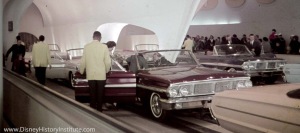 geniuses modified the cars so they were individually propelled underneath by a track. Sounds simple now. But, according to a Gurr, the Ford system took longer to design than to build Disneyland. He tells a story that because the cars were different lengths and had no bumpers, around certain turns they would smack into each other. The banging
geniuses modified the cars so they were individually propelled underneath by a track. Sounds simple now. But, according to a Gurr, the Ford system took longer to design than to build Disneyland. He tells a story that because the cars were different lengths and had no bumpers, around certain turns they would smack into each other. The banging  caused broken lights and damage. The Imagineers solved the problem with track design and a complex set of rules about which cars could be next to each other. And they employed a full time crew of car body repairmen during the run of the Fair to fix damage that still occurred. The Magic Skyway transport system is the grandfather of theme park, dark ride systems and is still used at The Haunted Mansion as well as powering the recent Little Mermaid: Ariel’s Undersea Adventure rides in both U.S. parks and many other rides. If you get on a continuously loading ride anywhere with all the cars connected, and it turns as the ride progresses so you face the action, you’re probably riding Skyway’s descendant, an Omnimover or a version of it.
caused broken lights and damage. The Imagineers solved the problem with track design and a complex set of rules about which cars could be next to each other. And they employed a full time crew of car body repairmen during the run of the Fair to fix damage that still occurred. The Magic Skyway transport system is the grandfather of theme park, dark ride systems and is still used at The Haunted Mansion as well as powering the recent Little Mermaid: Ariel’s Undersea Adventure rides in both U.S. parks and many other rides. If you get on a continuously loading ride anywhere with all the cars connected, and it turns as the ride progresses so you face the action, you’re probably riding Skyway’s descendant, an Omnimover or a version of it.
Much of Disney’s early animation success was built on the use of music to enhance the entertainment value of his films. Since Walt viewed theme parks attractions as another story telling method, the second common Fair attraction element was music. The Sherman brothers created two of the most famous ear worms in entertainment history. Both It’s a Small Word After All and It’s a Great, Big, Beautiful Tomorrow, not only, stick with riders long after exiting the attraction but they artfully reinforce the overall theme of both experiences. Since Walt did not copywrite Small World, his gift to the world has become the most publicly played song of all time.
The ride systems were certainly innovative and continue to be improved upon. Yet, it’s a different gadget that we all have come to love in Disney attractions and in lots of other 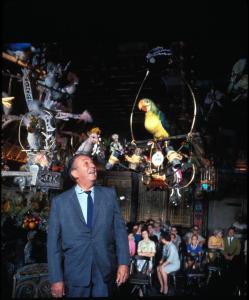 places. Legend has it that the first Audio-Animatronics appeared in the Disneyland’s Enchanted Tiki Room in 1963 because of a small mechanical bird Walt found in an antique shop. But, as usual, after simple figures in the Tiki Room and Jungle Cruise, Walt wanted to do more. He used the Fair to apply the patented technology to depicting people. The Lincoln figure turned out to be the most complex, “robot” at the time. It was so convincing, many guests left the show thinking that it was a real actor. AAs are used in many Disney park attractions and other theme parks. There are about 300 figures alone in Small World. Pirates in Disneyland has 53 AA animals, and 75 pirates and villagers. It wasn’t easy
places. Legend has it that the first Audio-Animatronics appeared in the Disneyland’s Enchanted Tiki Room in 1963 because of a small mechanical bird Walt found in an antique shop. But, as usual, after simple figures in the Tiki Room and Jungle Cruise, Walt wanted to do more. He used the Fair to apply the patented technology to depicting people. The Lincoln figure turned out to be the most complex, “robot” at the time. It was so convincing, many guests left the show thinking that it was a real actor. AAs are used in many Disney park attractions and other theme parks. There are about 300 figures alone in Small World. Pirates in Disneyland has 53 AA animals, and 75 pirates and villagers. It wasn’t easy 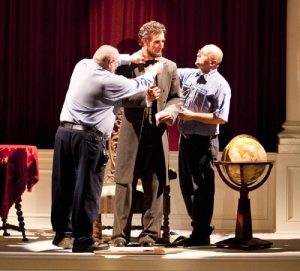 getting Lincoln to behave. In fact, the President missed his targeted opening date. Walt had to tell a room full of VIPs that he wouldn’t present the show until it was perfect. Finally, the WED Imagineers solved the problems and the show opened to rave reviews. The same design was used for the COP figures. These days, it’s hard to think of Disney, or, for that matter, many theme parks without thinking about AAs. Decades after their introduction, they continue to be added and improved in new attractions and new theme parks.
getting Lincoln to behave. In fact, the President missed his targeted opening date. Walt had to tell a room full of VIPs that he wouldn’t present the show until it was perfect. Finally, the WED Imagineers solved the problems and the show opened to rave reviews. The same design was used for the COP figures. These days, it’s hard to think of Disney, or, for that matter, many theme parks without thinking about AAs. Decades after their introduction, they continue to be added and improved in new attractions and new theme parks.
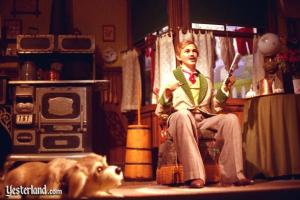 Everyone at WED who was involved with the Fair has said that while Walt was involved with all the projects, there’s more of Walt in Carousel of Progress than anything WED ever did. The show captured much of the sensibilities with which he infused all his creative work. It has a nostalgic Midwestern feel. The GE sponsorship allowed the characters to celebrate one of Walt’s favorite themes, the march of innovative technology making lives better. The design of the rotating theater was a way to mimic the quick transitions done in film. The Carousel Theater was guest-friendly and efficient enabling the theater sections to entertain six audiences simultaneously. With a new show starting every four minutes no one had to wait for long show to end to enter. WED employees who were around, say Walt put the final touch in place by adding a “weenie”, the dog, to each of the scenes.
Everyone at WED who was involved with the Fair has said that while Walt was involved with all the projects, there’s more of Walt in Carousel of Progress than anything WED ever did. The show captured much of the sensibilities with which he infused all his creative work. It has a nostalgic Midwestern feel. The GE sponsorship allowed the characters to celebrate one of Walt’s favorite themes, the march of innovative technology making lives better. The design of the rotating theater was a way to mimic the quick transitions done in film. The Carousel Theater was guest-friendly and efficient enabling the theater sections to entertain six audiences simultaneously. With a new show starting every four minutes no one had to wait for long show to end to enter. WED employees who were around, say Walt put the final touch in place by adding a “weenie”, the dog, to each of the scenes.
Walt also had a giant model of “Progress City” seen through the windows in the last scene, which guests could get a better look at when exiting the theater. Take a look at my posts, The Unfulfilled Promise of E.P.C.O.T. and The Legacy of Walt Disney’s E.P.C.O.T. to learn more about Progress City and Walt’s interests in urban planning and leveraging  American industry’s innovative abilities. Walt had already begun buying up land in Florida, so those plans must have been already percolating. You can still sneak a quick peak at a portion of the model of Walt’s ideas for the city of the future when you ride the Tomorrowland Transit Authority Peoplemover.
American industry’s innovative abilities. Walt had already begun buying up land in Florida, so those plans must have been already percolating. You can still sneak a quick peak at a portion of the model of Walt’s ideas for the city of the future when you ride the Tomorrowland Transit Authority Peoplemover.
The Magic Skyway had similar city of the future themes, focused on humorous AA scenes of innovation over the centuries, like the invention of the wheel. The Skyway track system concept was used to create the WEDWay PeopleMover ride at Disneyland a few years later and was to be an integral part of Walt’s Prototype Community in Florida. Disney Imagineers also contributed tiny scale models of Scenes from 11 nations, past and present in the International Garden as guests entered the Ford pavilion.
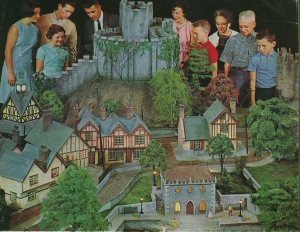
Always the innovator and always the promoter, Walt saw the Fair as a multi-faceted opportunity  to extend the Disney brand and worked it out so that Small World, Lincoln and COP would have future homes at Disneyland. Sadly, the only physical part of the Magic Skyway salvaged was the dinosaur AAs, which found a new home in the Primeval World diorama along the Disneyland Railroad.
to extend the Disney brand and worked it out so that Small World, Lincoln and COP would have future homes at Disneyland. Sadly, the only physical part of the Magic Skyway salvaged was the dinosaur AAs, which found a new home in the Primeval World diorama along the Disneyland Railroad.
Much of the work that went into the creation of the attractions continues to impact how theme park entertainment is designed and executed. All the Disney parks around the world except for Shanghai have a version of Small World. And boat ride systems are used in theme parks around the world. The Fair themes of peace and innovative advancement were central to how Disney built his company. While many of the attractions were designed to educate the public, Disney Fair attractions, made the medicine go down easier by infusing humor such as in COP, whimsy in Small World and wow factor experienced in Lincoln and Magic Skyway. The two years in NY may represent the beginning of the end for what people nostalgically think of when they “remember” World’s Fairs. The contributions of Walt and his magical Imagineers are probably one of the reasons the 1964 Fair remains an iconic example of creativity, innovation and invention.










Comments on: "Walt Disney Goes to the Fair" (3)
[…] advancements accelerated by WED’s work for the 1964 NY World’s Fair. (See my posts Walt Disney Goes to the Fair and Report on D23’s “Behind the Scenes” NYC Event for more Disney Fair info) And we can see […]
LikeLike
[…] the great tennis being played at the US Tennis Center in Flushing Meadows (Also the site of the 1964 World’s Fair that Disney headlined). I love sports in general. But there’s something about the competitions […]
LikeLike
[…] to ride it at the 1964 NY World’s Fair, it has been part of my life for a long time. (See my post Walt Disney Goes to the Fair and a D23 Gold Member NYC event where we visited the original site of Small World). I will say, […]
LikeLike